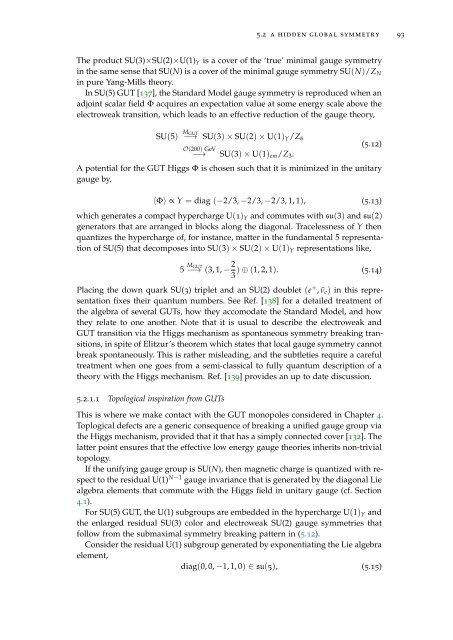Topology, symmetry, and phase transitions in lattice gauge ... - tuprints
Topology, symmetry, and phase transitions in lattice gauge ... - tuprints
Topology, symmetry, and phase transitions in lattice gauge ... - tuprints
Create successful ePaper yourself
Turn your PDF publications into a flip-book with our unique Google optimized e-Paper software.
5.2 a hidden global <strong>symmetry</strong> 93<br />
The product SU(3)×SU(2)×U(1) Y is a cover of the ‘true’ m<strong>in</strong>imal <strong>gauge</strong> <strong>symmetry</strong><br />
<strong>in</strong> the same sense that SU(N) is a cover of the m<strong>in</strong>imal <strong>gauge</strong> <strong>symmetry</strong> SU(N)/Z N<br />
<strong>in</strong> pure Yang-Mills theory.<br />
In SU(5) GUT [137], the St<strong>and</strong>ard Model <strong>gauge</strong> <strong>symmetry</strong> is reproduced when an<br />
adjo<strong>in</strong>t scalar field Φ acquires an expectation value at some energy scale above the<br />
electroweak transition, which leads to an effective reduction of the <strong>gauge</strong> theory,<br />
SU(5) M GUT<br />
−→ SU(3) × SU(2) × U(1) Y /Z 6<br />
O(200) GeV<br />
−→ SU(3) × U(1) em /Z 3 .<br />
(5.12)<br />
A potential for the GUT Higgs Φ is chosen such that it is m<strong>in</strong>imized <strong>in</strong> the unitary<br />
<strong>gauge</strong> by,<br />
〈Φ〉 ∝ Y = diag (−2/3, −2/3, −2/3, 1, 1), (5.13)<br />
which generates a compact hypercharge U(1) Y <strong>and</strong> commutes with su(3) <strong>and</strong> su(2)<br />
generators that are arranged <strong>in</strong> blocks along the diagonal. Tracelessness of Y then<br />
quantizes the hypercharge of, for <strong>in</strong>stance, matter <strong>in</strong> the fundamental 5 representation<br />
of SU(5) that decomposes <strong>in</strong>to SU(3) × SU(2) × U(1) Y representations like,<br />
5 M GUT<br />
−→ (3, 1, − 2 ) ⊕ (1, 2, 1). (5.14)<br />
3<br />
Plac<strong>in</strong>g the down quark SU(3) triplet <strong>and</strong> an SU(2) doublet (e + , ¯ν e ) <strong>in</strong> this representation<br />
fixes their quantum numbers. See Ref. [138] for a detailed treatment of<br />
the algebra of several GUTs, how they accomodate the St<strong>and</strong>ard Model, <strong>and</strong> how<br />
they relate to one another. Note that it is usual to describe the electroweak <strong>and</strong><br />
GUT transition via the Higgs mechanism as spontaneous <strong>symmetry</strong> break<strong>in</strong>g <strong>transitions</strong>,<br />
<strong>in</strong> spite of Elitzur’s theorem which states that local <strong>gauge</strong> <strong>symmetry</strong> cannot<br />
break spontaneously. This is rather mislead<strong>in</strong>g, <strong>and</strong> the subtleties require a careful<br />
treatment when one goes from a semi-classical to fully quantum description of a<br />
theory with the Higgs mechanism. Ref. [139] provides an up to date discussion.<br />
5.2.1.1 Topological <strong>in</strong>spiration from GUTs<br />
This is where we make contact with the GUT monopoles considered <strong>in</strong> Chapter 4.<br />
Toplogical defects are a generic consequence of break<strong>in</strong>g a unified <strong>gauge</strong> group via<br />
the Higgs mechanism, provided that it that has a simply connected cover [132]. The<br />
latter po<strong>in</strong>t ensures that the effective low energy <strong>gauge</strong> theories <strong>in</strong>herits non-trivial<br />
topology.<br />
If the unify<strong>in</strong>g <strong>gauge</strong> group is SU(N), then magnetic charge is quantized with respect<br />
to the residual U(1) N−1 <strong>gauge</strong> <strong>in</strong>variance that is generated by the diagonal Lie<br />
algebra elements that commute with the Higgs field <strong>in</strong> unitary <strong>gauge</strong> (cf. Section<br />
4.1).<br />
For SU(5) GUT, the U(1) subgroups are embedded <strong>in</strong> the hypercharge U(1) Y <strong>and</strong><br />
the enlarged residual SU(3) color <strong>and</strong> electroweak SU(2) <strong>gauge</strong> symmetries that<br />
follow from the submaximal <strong>symmetry</strong> break<strong>in</strong>g pattern <strong>in</strong> (5.12).<br />
Consider the residual U(1) subgroup generated by exponentiat<strong>in</strong>g the Lie algebra<br />
element,<br />
diag(0, 0, −1, 1, 0) ∈ su(5), (5.15)
















